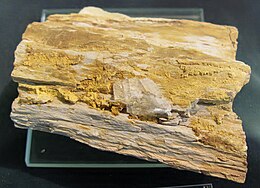Carnotite
| Carnotite | |
|---|---|
 Carnotite in fossilized wood from St. George, Utah | |
| General | |
| Category | Vanadate mineral |
| Formula (repeating unit) | K2(UO2)2 (VO4)2·3H2O |
| IMA symbol | Cnt[1] |
| Strunz classification | 4.HB.05 |
| Crystal system | Monoclinic |
| Crystal class | Prismatic (2/m) (same H-M symbol) |
| Space group | P21/a |
| Unit cell | a = 10.47 Å, b = 8.41 Å, c = 6.91 Å; β = 103.83°; Z = 2 |
| Identification | |
| Color | Bright yellow to lemon-yellow, may be greenish yellow. |
| Crystal habit | Crusts, earthy masses, foliated and granular aggregates. |
| Twinning | On {001} as both twin and composition plane |
| Cleavage | Perfect on {001}, micaceous |
| Fracture | uneven |
| Mohs scale hardness | 2 |
| Luster | Dull, earthy; silky when crystalline |
| Streak | yellow |
| Diaphaneity | Semitransparent |
| Specific gravity | 4.70 |
| Optical properties | Biaxial (−) |
| Refractive index | nα=1.750 – 1.780, nβ=1.901 – 2.060, nγ=1.920 – 2.080 |
| Birefringence | δ = 0.200 |
| 2V angle | Measured: 43° to 60°, Calculated: 26° to 36° |
| Other characteristics | |
| References | [2][3][4][5][6] |
Carnotite is a potassium uranium vanadate radioactive mineral with chemical formula K2(UO2)2(VO4)2·3H2O. The water content can vary and small amounts of calcium, barium, magnesium, iron, and sodium are often present.
Occurrence
[edit]
Carnotite is a bright greenish-yellow mineral that occurs typically as crusts and flakes in sandstones. Amounts as low as one percent will color the sandstone a bright yellow. The high uranium content makes carnotite an important uranium ore. It is a secondary vanadium and uranium mineral usually found in sedimentary rocks in arid climates.
In the United States it is an important ore of uranium in the Colorado Plateau region of the United States where it occurs as disseminations in sandstone[3] and concentrations around petrified logs. It also occurs in the U.S. states of Wyoming, Colorado, South Dakota, Nevada, Arizona, and Utah. It also occurs incidentally in Grants, New Mexico, and Carbon County, Pennsylvania.[7]
Carnotite is reported in Congo (Kinshasa), Morocco, Australia (Radium Hill) and Kazakhstan.[7] In Pakistan carnotite occurs in the Upper Miocene middle Siwaliks sandstone (Dhokpathan Formation), in the vicinity of Takhat Nasrati, Karak District.[citation needed]
Name and discovery
[edit]The mineral was first described in 1899 by French scientists M. M. C. Freidel and E. Cumenge, who identified it in specimens from Roc Creek in Montrose County, Colorado, United States.[8] It is named for Marie Adolphe Carnot (1839–1920), French mining engineer and chemist.[5]
Uses
[edit]Carnotite is an ore of uranium. At times in the early 20th century, it was mined primarily for radium or vanadium.
The mineral was used to produce quack devices involving radioactive substances.
Related mineral species
[edit]Several related mineral species exist, including: margaritasite ((Cs,K,H3O)2(UO2)(VO4)2·H2O) and tyuyamunite, (Ca(UO2)2(VO4)2·5-8H2O).
See also
[edit]References
[edit]- ^ Warr, L.N. (2021). "IMA–CNMNC approved mineral symbols". Mineralogical Magazine. 85 (3): 291–320. Bibcode:2021MinM...85..291W. doi:10.1180/mgm.2021.43. S2CID 235729616.
- ^ Mineralienatlas
- ^ a b Handbook of Mineralogy
- ^ Hurlbut, Cornelius S.; Klein, Cornelis, 1985, Manual of Mineralogy, 20th ed., John Wiley and Sons, New York ISBN 0-471-80580-7
- ^ a b Mindat.org
- ^ Webmineral
- ^ a b Mindat with locations
- ^ Robert J. Wright and Donald L. Everhart (1960) Uranium, in Mineral Resources of Colorado First Sequel, State of Colorado Mineral Resources Board, p. 330–331.
